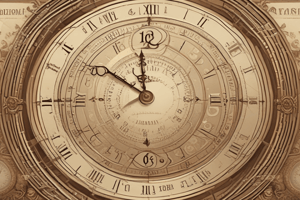Podcast
Questions and Answers
Tell Brak was located in southeastern Syria.
Tell Brak was located in southeastern Syria.
False (B)
Tell Brak served as a royal center during the fourth and third millennia B.C.
Tell Brak served as a royal center during the fourth and third millennia B.C.
True (A)
The Eye Temple is named after the small figurines with pronounced eyes found in its mortar.
The Eye Temple is named after the small figurines with pronounced eyes found in its mortar.
True (A)
The main agricultural land surrounding Tell Brak was arid steppe.
The main agricultural land surrounding Tell Brak was arid steppe.
Tell Brak became a provincial capital during the Akkadian Empire.
Tell Brak became a provincial capital during the Akkadian Empire.
Skeletal remains indicate Tell Brak was known for horses used in drawing wheeled carts.
Skeletal remains indicate Tell Brak was known for horses used in drawing wheeled carts.
The palace of Naramsin stored tribute and agricultural products during the Akkadian period.
The palace of Naramsin stored tribute and agricultural products during the Akkadian period.
The city of Tell Brak was not plundered after the fall of the Akkadian Empire.
The city of Tell Brak was not plundered after the fall of the Akkadian Empire.
Study Notes
Overview of Tell Brak
- Ancient Nagar, known as Tell Brak, was a prominent royal center in northern Mesopotamia during the 4th and 3rd millennia B.C.
- Strategically located on a major route that connected Anatolia’s mountains to southern Mesopotamian cities.
- Positioned at the transition between rainfall agriculture and arid steppe, serving as pasture land for nomads.
- The site marked significant cultural interactions between northern and southern Mesopotamia.
Notable Features and Structures
- Renowned for its rich sequence of temples from the late Uruk and Jemdet Nasr periods, indicating its importance.
- Residential houses from this era featured long, narrow courtyards with domed ovens, conducive for large gatherings.
- Skeletal remains indicate the site produced donkey-onager mules, essential for cart transport before the horse's introduction around 2300 BCE.
- The Eye Temple, famous for numerous "eye idol" figurines, is a key archaeological highlight from the 4th millennium B.C.
- The temple's architecture was lavishly adorned with clay cones, copper panels, and gold, reminiscent of contemporary Sumer temples.
Historical Context
- In the 3rd millennium B.C., Tell Brak became a provincial capital under the Akkadian Empire.
- The palace of Naramsin functioned primarily as a storage depot for tribute, loot, and agricultural products rather than a residential space.
- Cuneiform records from this period designate Nagar as a significant hub connecting the Levant and northern Mesopotamia.
Later Developments
- Post-Akkadian Empire, the site faced plundering; however, the palace was reconstructed during the UR III Period by Ur Nammu.
- In the 2nd millennium B.C., a smaller but significant Late Bronze Age palace and temple of Mitanni were constructed at the site, dating approximately from 1500–1360 BCE.
- The area showed continuous domestic occupation spanning from around 1700 to 1200 BCE, illustrating the site's ongoing historical significance.
Studying That Suits You
Use AI to generate personalized quizzes and flashcards to suit your learning preferences.
Description
This quiz explores Tell Brak, an important archaeological site in northeastern Syria that served as a royal center in northern Mesopotamia during the fourth and third millennia B.C. It highlights its strategic location along trade routes and its significance in cultural interactions between different communities. Test your knowledge about this ancient civilization!




